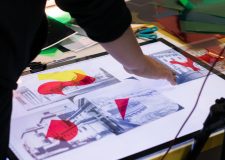Royal recognition for Brighton businessman
The man behind more than 300 business start-ups wins royal recognition in London today for his wealth-generating work.
Frank le Duc reports

The Queen is due to recognise a remarkable Brighton success story on Tuesday 23 July with a reception at Buckingham Palace. Among those being lauded will be the midwife to more than 300 businesses born at the Sussex University campus in Falmer. Mike Herd, executive director of the Sussex Innovation Centre, is being honoured with a Queen’s Award for Enterprise Promotion.
Mr Herd, 54, one of only eight people in the country to receive a Queen’s Award for Enterprise Promotion, has run the Sussex Innovation Centre (SInC) since 1997. His award recognises a significant contribution to encouraging entrepreneurship. The 300-plus start-ups to have come out of the Innovation Centre have attracted more than £25 million of investment and generated a combined income of more than half a billion pounds.
All this has come from an initial investment of £1.8 million in public funding, largely for the land and building. The Innovation Centre is financially self-sustaining. Under Mr Herd’s leadership it has doubled in size. And there are plans to extend its reach with an annex on a site behind Brighton Station known as Block J.
Despite the Innovation Centre’s success, not everyone in the area knows about it. When the Brighton and Hove Chamber of Commerce hosted it annual State of the City Debate a fortnight ago, business incubation was one of the subjects raised. It fell to Linda Buckham, another senior figure at Sussex University, who was in the audience, to highlight the efforts being made to nurture fledgling firms at the Falmer campus.
Mr Herd has described the role of the Innovation Centre as “to support the creation and growth of high technology and innovative businesses in a financially sustainable way that provides value to the University of Sussex and the regional economy”. It was started as the flagship development at the top end of the “academic corridor” – a collaboration between the area’s academic institutions, the public sector and the business world.
The academic corridor runs from Falmer, down the Lewes Road and into the centre of Brighton. It takes in Sussex University, Brighton University and City College Brighton and Hove. At the southern end is Brighton University’s Grand Parade site and the old fruit and veg market in Circus Street, which is due to be redeveloped and become part of the university.
PERFORMANCE
When it all began, the universities, City College, Brighton and Hove Council and East Sussex County Council were trying to tackle a relatively poor local economy.
The population was well qualified compared to many parts of the country but this wasn’t reflected in the area’s economic performance.
Mr Herd said: “Innovation centres weren’t really known at the time. There are probably about 300 now. We were one of the first half dozen. There were science parks. The radical thing was that it was set up as a business – not reliant on public money. We’re now a wholly owned subsidiary of the university.
“I came in after six to eight months as the first chief executive. It was a hothouse environment. The building was a shell. The roof leaked. The first companies came here because we had a free car park. Of the first five companies, one floated and two did very well. I had no experience. I came from the oil industry.”
Mr Herd said that he asked those starting a business at the Innovation Centre: “What’s stopping you?” His role, he said, was about creating networks, adding: “Rather than setting yourself up as an expert, you ask about the obstacles. You get to work out which are the generic problems.
“Our approach is about incubating academics rather than trying to license patents. We have five PhD-level experts auditing departments for ideas which could be patented and licensed. The old model involved having PhD-level physicists talking to physicists.” He said that this model had its shortcomings. The Innovation Centre’s approach focused more on customers and markets, he said, adding: “I have marketing people who talk to the academics. A lot of this is about building ways to get ideas to the market.”
ADVANCED
The Innovation Centre occupies about 50,000 sq ft and houses three teams – facilities, including advanced telecoms support, accountancy and management services, and business support. Mr Herd said: “We run this as a commercial building so we charge rent. We build management information systems. The reason we did this was that two companies were going through trade sales that almost failed because the management information was so poor.”
Again, businesses at the Innovation Centre pay for these services. Business support includes mentoring. Staff time also comes at a price. Mr Herd said: “We had
lots of techies with ideas but they weren’t investible. We get them to focus on finding the first customer. The business model needs to explain how a big company would use the technology. We introduce management techniques, market analysis and research. I focus on strategy.
“It’s not about trying to be clever. We take people seriously. You believe them. How they deliver that idea and to what market might completely change in that first meeting. It’s the easiest thing to pick holes in someone’s business plan. What’s harder is finding people to take them to the next level.”
Most of the businesses started at the Innovation Centre have become successful, profitable and sustainable. Sussex University said: “The centre has frequently been
cited as an example of best practice for business incubation.” It has also taken a direct role in commercialising research at the university. One notable success has been the joint development of electric potential sensor (EPS) technology with Plessey Semiconductors.
The Epic sensors developed through the collaboration have many applications. Mr Herd described them as the Innovation Centre’s “crown jewels”. The first product using the award-winning technology will be a hand-held electrocardiogram (ECG) device. Non-contact medical devices reduce the risk of infection and the need for invasive procedures.
But the technology can also be used for security and policing, for example, as well as for medical purposes. Using an Epc sensor, Mr Herd said, “I can see through walls
and see if there’s someone there and whether it’s a person or a goat.” There’s even a potential driver drowsiness application in the pipeline..
HONOUR
Mr Herd, a married father of two, enjoyed international travel in the oil industry and working offshore before his career change brought him to Sussex, where his parents hail from. He said: “I looked around and everyone earned well but they seemed to be drunk or divorced.” He doesn’t regret the move.
He said: “It’s a tremendous honour to receive this award. During my 16 years here I have seen countless extraordinarily smart and talented individuals come through our doors. It is a source of great professional pride to me that we have been able to help so many of them on their journey towards richly deserved success.”
Cabinet minister Vince Cable, the Secretary of State for Business, Innovation and Skills, is due to present Mr Herd with a chalice at his department’s offices in Westminster on Tuesday 23 July. Then Mr Herd and the other recipients are due to head to Buckingham Palace for the reception with the Queen.
Mr Herd said: “You’re given the award by Vince Cable at 1 Victoria Street. When it was announced he sent me a very nice handwritten note. He visited here in January. It’s nice because you don’t apply for it. And it’s nice because it’s an affirmation of when you really put yourself into something.” Mr Herd was nominated by Peter Harman, the chief executive of a national organisation called UK Business Incubation.
Like many recipients of honours and awards, he believes that it is also a reflection of the work of the team that he leads. And he said: “I have no intention of resting on my laurels. There is still so much more that we can do to nurture entrepreneurial talent in Brighton and beyond. I am as determined as ever to help uncover the next great innovation that will drive us on to even bigger and better things.”




















